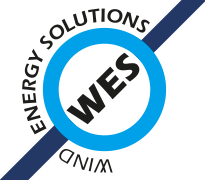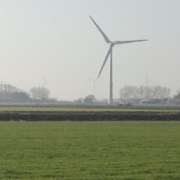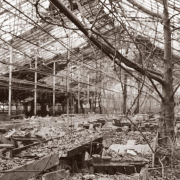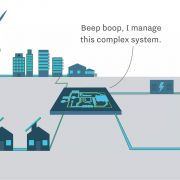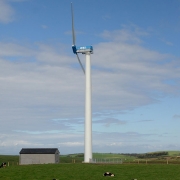How many blades are best for wind energy production?
The vast majority of wind turbines currently being installed have three blades. Why not four? Or two? Or a lot more to catch as much wind as possible?
The quick answer is that a two bladed wind turbine is already great for great efficiency. With two blades you need significantly less material, construction and maintenance costs. A third or fourth rotor blade makes the wind turbine marginally more efficient, while the construction and material costs increase considerably. The four blades of our historic wind mills were more of a practical choice.
The four blades of our historic wind mills were more of a practical choice.
Betz Law
Albert Betz formulated the law in 1919 that an ideal rotor can extract a maximum of 59% of the energy from the wind. If you get more energy out of the wind, the wind slows down further, that reduces the supply of wind to the turbine. An ideal rotor has endlessly infinitely narrow turbine blades, but according to a document that Siemens drew up in 2007 in which they deal with our question, it is stated that modern three-bladed wind turbines come to 80% of the Betz limit thanks to a smart blade design and a well-chosen rotation speed; a two-bladed turbine would achieve 5% less efficiency, but will have a higher return on investment because of the lower costs.
Two-bladed wind turbines offer a number of distinct advantages over three-bladed wind turbines.
The major advantage of having a reduced number of blades (and pitch drives) is the rotor weight (and therefore material) they approximately 30% less heavy than a comparable three-bladed rotor (Aerodyne engineering GmbH, 2014). Moreover, as two-bladed rotors operate at a higher rotational speed, the torque on the shaft is lower and more consequently the rotor and nacelle (which houses for instance the generator and drivetrain) are lighter. Another convenience of a rotor with less than three blades is that they can be turned horizontally during storms so they are less likely to be hit by lightning.
Two-bladed rotors are approximately 30% less heavy than a comparable three-bladed rotor
Another advantage can be found during transportation and construction: a two-bladed rotor can be transported fully preassembled and pretested on a ship’s deck to the wind farm site (De Vries, 2011). Finally, extreme loads can be considerably reduced by using horizontal parking of the rotor (Aerodyne engineering GmbH, 2014). Due to reduced extreme loads, the tower and foundation can be designed lighter.
Matter of taste
Roberto Delgado, principal engineer at 2-B Energy: “it’s a matter of taste to choose between two or three bladed wind turbines”. Some just prefer three-bladed models because they say they are more aesthetic. Delgado wants to breathe new life into the two-bladed wind turbines. A two-bladed 6 MW 2-B Energy wind turbine has now been installed in Eemshaven for six years. Through individual pitch control (IPC), independently controlling the pitch of each turbine blade, this wind turbine can take away much of the dynamic load. Check out how our pitching technique works https://windenergysolutions.nl/technology/
Storm resilience
A major disadvantage in areas with the most constant good wind is that they can turn into strong storms and hurricanes periodically. Most wind turbines cannot withstand the high wind speeds that these weather conditions entail. 2-bladed wind turbines can easily be brought down quickly with one crane instead of the two cranes, most thee-bladed turbines demand.
Our in-board-hoisting-crane can greatly reduce the maintenance costs of the two-bladed wind energy installations.
Our entire range of wind turbines can be equipped with an in-board-hoisting-crane which can be easily operated to secure the entire technical installation of the turbine, without external crane within a few hours. In this way, no high costs have to be incurred for supplying and using any mobile crane installation.
A second advantage of this built-in elevator construction is that inspections on the rotor and major maintenance can also be carried out without equipment from external sources. In addition to the advantages of the installation compared to three-bladed wind turbines, this greatly reduces the maintenance costs of the two-bladed wind energy installations.
Check out our animation of the in-board-hoisting-crane in action.
Forecast
Delgado foresees turbines of 10, 12 or more megawatts are going back to the two-bladed design. Dynamic load can always be better controlled with good steering. According to Delgado, a two-blade design for a wind turbine in the year 2019 has less than 3% lower efficiency than its three-leaf counterpart with the same diameter. You then get extra electricity from longer turbine blades, while you can still continue to benefit from lower construction, material and maintenance costs.
A number of companies have begun developing and building large two-bladed wind turbines (Schorbach and Dalhoff, 2012; Clover and Snieckus, 2014). This renewed interest in two-bladed wind turbines is mainly motivated by the increased focus on offshore wind energy. Cost of energy reduction of 10−12% is stated and in Clover and Snieckus (2014) a 20% reduction, on paper, is mentioned for two-bladed wind turbines. The potential cost of energy reduction makes that two-bladed turbines are an interesting opportunity which manufactures are actively exploring.
